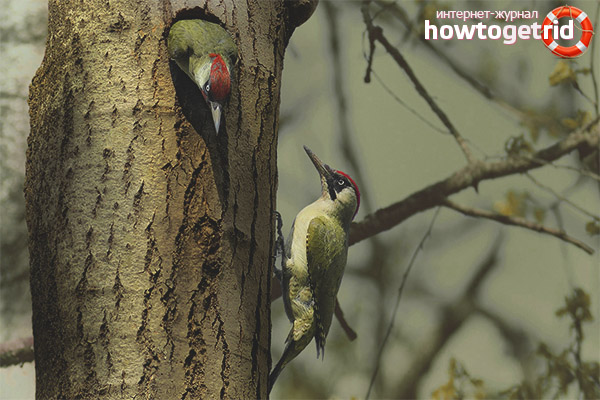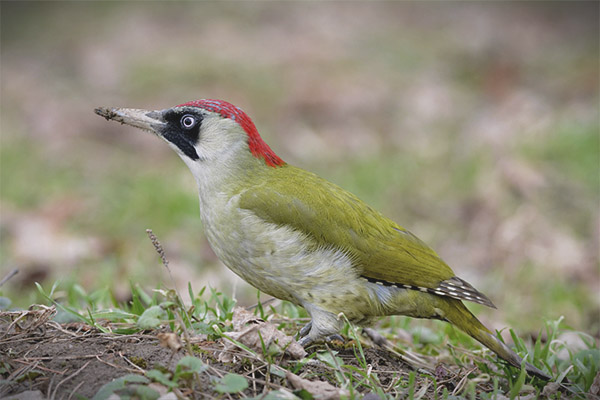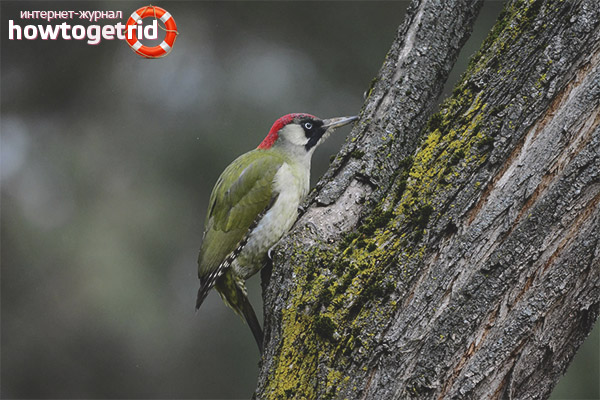The content of the article
In Europe, a large and unusually beautiful bird with a green robe dwells in the areas occupied by deciduous and mixed forests, it is called the green woodpecker. The back and wings are painted olive-green, the belly and the front of the neck have light green plumage, and sometimes can be greenish-gray, decorated with dark markings.
To both sides of the beak of a woodpecker, two strips diverge, in their form similar to the mustache of a cavalryman. In females, they are painted black, in males in red, having a black border. On the nape of the adult bird there is a red spot, shaped like a cardinal hat. A black spot is located around the eyes of a woodpecker, surrounded by rounded green cheeks and a red “cardinal cap” black spots look like a carnival mask.All green woodpeckers have a yellow-green plumage on the upper tail and a beak painted in lead-gray.
Females with males have the only difference expressed by the color of their whiskers. Immature individuals do not have a mustache, their eyes have a dark gray tint, and the eyes of adults — birds — bluish-white.
On the paws of a woodpecker there are four fingers with sharp and tenacious claws. With the help of its claws, this bird is able to hold onto the vertical surfaces of tree trunks, leaning on a rigid tail.
Singing features
The green woodpecker is capable of making loud enough monotone two-syllable sounds, and the second syllable, which sounds much louder, receives an explicit accent. Voice signals males and females emit the same, they can be heard throughout the year. The sound looks monotonous without sharp contrasts in tonality. The singing of a green woodpecker is not accompanied by clicking and chattering, and if you have to hollow trees, like other woodpeckers do, he is taken for this exercise with great reluctance.
Diet
Although the main ration consists of forest and red ants, they can eat snails, earthworms, woodcutter larvae, and also hawk caterpillars. In addition, woodpeckers willingly catch wild bees, sitting near the hive. Less often, they feed on plant foods, which constitute only an additional part of their diet; these can be fallen fruits of forest apple, persimmon, sweet cherry, mulberry, pear, cherry and grapes. Sometimes they eat berries or seeds.
In the autumn-winter period, especially after the first snow falls, the ants become very difficult prey, because they hide under the ground for the winter. But green woodpeckers manage to find them even in winter, digging whole tunnels in the snow.In addition to ants, they know where many other insects are hiding, although in winter they more readily eat winter rowan and yew berries.
Mating games

Green woodpeckers may become sexually mature by the end of the 1st year of life, and are ready to break into mating. Males spend the winter period separately with females until the third decade of February. During this period, they begin to experience attraction to members of the opposite sex. Caring and flirting can continue until April.
With the onset of spring, when the sun begins to warm the earth, the excitement of woodpeckers reaches its highest point. They with loud cries jump through the trees, actively creating advertising for the place chosen for the nest. The calls of males are expressed by frequent and very loud cries, but the sounds of drumming, which often emit the rest of woodpeckers, green woodpeckers use extremely rarely.
At the very beginning of the mating season, woodpeckers arrange their noisy games in the morning, and when the season comes to an end - their cries can be heard only in the evening time. When the female arrived at the call of the male and gave him an answer, the theater of action is just beginning.They continue to call out, gradually coming closer, until they sit down on one branch and touch each other with their beaks. After that, the male must perform another ritual, present his wedding treat to his girlfriend. Only after all the conventions are met, the birds mate.
Green woodpeckers form a pair only for 1 season, however, due to their linkage to one place, it is not uncommon that last year’s partners meet again. This feature distinguishes them from gray-haired woodpeckers, who often migrate and rarely stay two years in the same place. Green individuals lead exclusively sedentary lifestyles, not flying away from the place of constant overnight stay further than 5 kilometers.
The period of breeding offspring
For the device of the nest of a bird of this look beat out a convenient hollow which can be used many years later. If in the future they have to move, then not far, they, as a rule, equip a new dwelling within a kilometer from the old one. Both partners take part in the hollowing of the hollow tree, but nevertheless the male does the lion's share of the work.
The hollow gets its location in a tree trunk or in a thick side branch; the birds' height is not less than 2 meters from the ground, but not more than 10 meters. Woodpeckers find a hollow tree for wood with an empty heart or completely dry, but still soft wood is preferred.
The cross-section of the nest, built by green woodpecker, is about 18 centimeters, and its depth can reach half a meter. Hole to enter the hollow they make within 7 centimeters. As a laying floor, these birds use a layer of refractory wood. Construction of the next nest can take up to 4 weeks.
The female can lay its laying in the period from the last decade of March to the first days of June, from 5 to 8 eggs, oblong in shape with a glossy shell can be found in the laying. She sits on the clutch only after the last egg has been laid, the incubation period can last from 14 to 17 days. Both parents are engaged in incubation of offspring, replacing each other with an interval of 2 hours, and at night sometimes the male sits on the clutch.
Woodpecker chicks hatching synchronously, all in one day, both parents are engaged in feeding the offspring, they fly with a full goiter and divide their prey equally into all, spitting up each part of it.While the chicks are in the nest, parents are forced to follow all the rules of secrecy, so as not to attract too much attention to defenseless offspring.
On the 23rd day of life, the chicks make the first attempts to leave the nest, they still do not know how to fly, but they are already actively moving along the branches and the trunk of the tree. Gradually, the first flight attempts are made, which each time become more and more successful, but everyone still lives in the nest. Only when the youth will surely be on the wing, half of the brood will follow the male, and the other will follow the female, the parents will take care of their babies for 7 weeks until they become independent birds.
Curious facts
The green woodpecker is a great glutton and gourmet, in search of its prey it can fly several kilometers. The singing of a green woodpecker cannot be confused with anyone, its plumage is so colored that it is much easier to hear a bird than to see it. But the one who ever heard the woodpecker, no longer confuse him with anyone.
The famous sound reminiscent of the frequent drumming, which is made by all woodpeckers, among other things, serves as a way for them to communicate. To make the sound loud, the woodpecker hammer on the dry branches.
Video: green woodpecker (Picus viridis)












To send